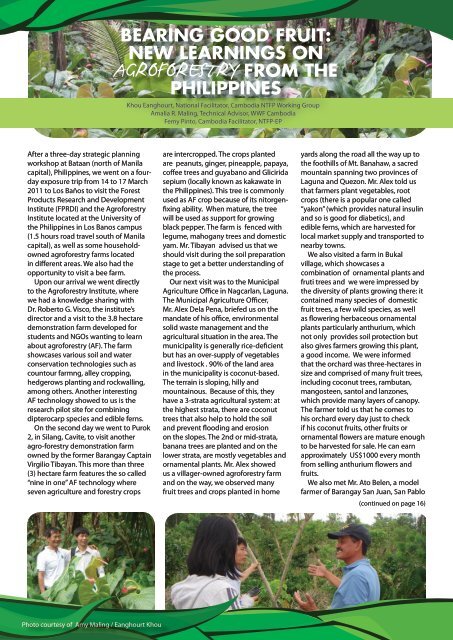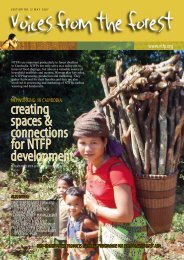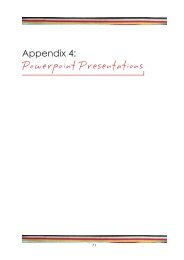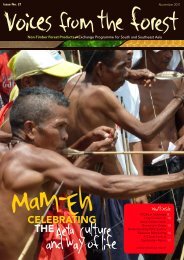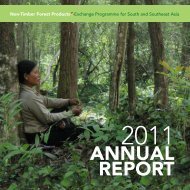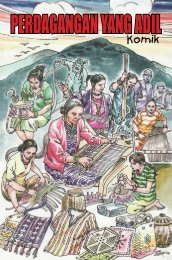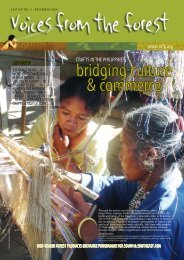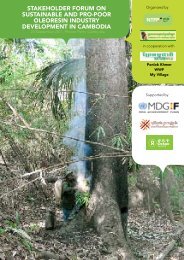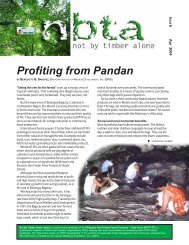Edition No. 20 - Non-Timber Forest Products Exchange Programme
Edition No. 20 - Non-Timber Forest Products Exchange Programme
Edition No. 20 - Non-Timber Forest Products Exchange Programme
Create successful ePaper yourself
Turn your PDF publications into a flip-book with our unique Google optimized e-Paper software.
BEARING GOOD FRUIT:<br />
NEW LEARNINGS ON<br />
FROM THE<br />
PHILIPPINES<br />
AGROFORESTRY<br />
Khou Eanghourt, National Facilitator, Cambodia NTFP Working Group<br />
Amalia R. Maling, Technical Advisor, WWF Cambodia<br />
Femy Pinto, Cambodia Facilitator, NTFP-EP<br />
After a three-day strategic planning<br />
workshop at Bataan (north of Manila<br />
capital), Philippines, we went on a fourday<br />
exposure trip from 14 to 17 March<br />
<strong>20</strong>11 to Los Baños to visit the <strong>Forest</strong><br />
<strong>Products</strong> Research and Development<br />
Institute (FPRDI) and the Agroforestry<br />
Institute located at the University of<br />
the Philippines in Los Banos campus<br />
(1.5 hours road travel south of Manila<br />
capital), as well as some householdowned<br />
agroforestry farms located<br />
in different areas. We also had the<br />
opportunity to visit a bee farm.<br />
Upon our arrival we went directly<br />
to the Agroforestry Institute, where<br />
we had a knowledge sharing with<br />
Dr. Roberto G. Visco, the institute’s<br />
director and a visit to the 3.8 hectare<br />
demonstration farm developed for<br />
students and NGOs wanting to learn<br />
about agroforestry (AF). The farm<br />
showcases various soil and water<br />
conservation technologies such as<br />
countour farmng, alley cropping,<br />
hedgerows planting and rockwalling,<br />
among others. Another interesting<br />
AF technology showed to us is the<br />
research pilot site for combining<br />
dipterocarp species and edible ferns.<br />
On the second day we went to Purok<br />
2, in Silang, Cavite, to visit another<br />
agro-forestry demonstration farm<br />
owned by the former Barangay Captain<br />
Virgilio Tibayan. This more than three<br />
(3) hectare farm features the so called<br />
“nine in one” AF technology where<br />
seven agriculture and forestry crops<br />
are intercropped. The crops planted<br />
are peanuts, ginger, pineapple, papaya,<br />
coffee trees and guyabano and Glicirida<br />
sepium (locally known as kakawate in<br />
the Philippines). This tree is commonly<br />
used as AF crop because of its nitorgenfixing<br />
ability. When mature, the tree<br />
will be used as support for growing<br />
black pepper. The farm is fenced with<br />
legume, mahogany trees and domestic<br />
yam. Mr. Tibayan advised us that we<br />
should visit during the soil preparation<br />
stage to get a better understanding of<br />
the process.<br />
Our next visit was to the Municipal<br />
Agriculture Office in Nagcarlan, Laguna.<br />
The Municipal Agriculture Officer,<br />
Mr. Alex Dela Pena, briefed us on the<br />
mandate of his office, environmental<br />
solid waste management and the<br />
agricultural situation in the area. The<br />
municipality is generally rice-deficient<br />
but has an over-supply of vegetables<br />
and livestock . 90% of the land area<br />
in the municipality is coconut-based.<br />
The terrain is sloping, hilly and<br />
mountainous. Because of this, they<br />
have a 3-strata agricultural system: at<br />
the highest strata, there are coconut<br />
trees that also help to hold the soil<br />
and prevent flooding and erosion<br />
on the slopes. The 2nd or mid-strata,<br />
banana trees are planted and on the<br />
lower strata, are mostly vegetables and<br />
ornamental plants. Mr. Alex showed<br />
us a villager-owned agroforestry farm<br />
and on the way, we observed many<br />
fruit trees and crops planted in home<br />
yards along the road all the way up to<br />
the foothills of Mt. Banahaw, a sacred<br />
mountain spanning two provinces of<br />
Laguna and Quezon. Mr. Alex told us<br />
that farmers plant vegetables, root<br />
crops (there is a popular one called<br />
“yakon” (which provides natural insulin<br />
and so is good for diabetics), and<br />
edible ferns, which are harvested for<br />
local market supply and transported to<br />
nearby towns.<br />
We also visited a farm in Bukal<br />
village, which showcases a<br />
combination of ornamental plants and<br />
fruti trees and we were impressed by<br />
the diversity of plants growing there: it<br />
contained many species of domestic<br />
fruit trees, a few wild species, as well<br />
as flowering herbaceous ornamental<br />
plants particularly anthurium, which<br />
not only provides soil protection but<br />
also gives farmers growing this plant,<br />
a good income. We were informed<br />
that the orchard was three-hectares in<br />
size and comprised of many fruit trees,<br />
including coconut trees, rambutan,<br />
mangosteen, santol and lanzones,<br />
which provide many layers of canopy.<br />
The farmer told us that he comes to<br />
his orchard every day just to check<br />
if his coconut fruits, other fruits or<br />
ornamental flowers are mature enough<br />
to be harvested for sale. He can earn<br />
approximately US$1000 every month<br />
from selling anthurium flowers and<br />
fruits.<br />
We also met Mr. Ato Belen, a model<br />
farmer of Barangay San Juan, San Pablo<br />
(continued on page 16)<br />
Photo courtesy of Amy Maling / Eanghourt Khou


